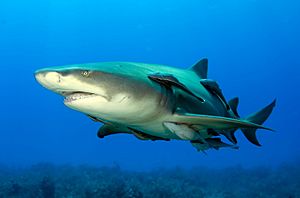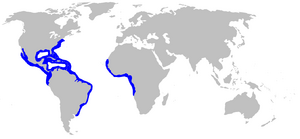Lemon shark facts for kids
Quick facts for kids Lemon shark |
|
|---|---|
 |
|
| A Lemon shark swimming with Remoras in the Bahamas | |
| Conservation status | |
| Scientific classification | |
| Kingdom: | |
| Phylum: | |
| Class: | |
| Order: | |
| Family: | |
| Genus: | |
| Species: |
N.brevirostris
|
 |
|
| Range of the Lemon shark | |
| Synonyms | |
|
Carcharias fronto Jordan & Gilbert, 1882 |
|
The Lemon shark is a shark that gets its name from its deep yellow back. Its belly is off-white. Lemon sharks are usually eight to ten feet long. They have long, sharp teeth for catching slippery fish. Lemon sharks are common on the southeast coast of the United States of America.
Contents
Description
The Lemon shark gets its name from the fact that it is yellow in colour. The underside is usually white or a lighter yellowish colour. Besides yellow, the Lemon shark is also brown and olive grey in colour.
The Lemon shark is stocky, blunt-nosed, and has two dorsal fins of similar size and shape. The first dorsal fin is low and positioned at the back of the pectoral fins, and the second dorsal is of similar shape and size and positioned at the front of the anal fin. The pelvic fin weakly concave (curving inwards) rear margins, and the pectoral fin's outer margin is slightly convex (curving outwards), and both fins are weakly falcate. The snout is round and shorter than the width of the mouth.
There is no mid-dorsal ridge present on this species.
The upper teeth are narrow and broad with triangular smooth-edged cusps and finely serrated bases. These teeth get more oblique as they get closer to the corner of the mouth. The lower teeth are narrow and triangular with smooth-edged cusps.
Lemon shark scales are large and overlapping with 3 to 5 ridges. The middle ridge is high, sharp and separated by deep furrows, and the back margins are opposite the primary ridges. The basal plates and pedicels are broad.
Lemon sharks can grow to 3.4 metres (11 ft) in length. Pups are between 24-26 inches (60-65 cm) at birth.
Reproduction
The Lemon shark is viviparous, meaning that they give live birth. After a gestation period of 10 to 12 months, pregnant females enter shallow nursery areas in spring and summer to give birth to litters of 4 to 17 pups.
The pups have a very slow growth rate and remain within nursery grounds for quite a long time, where they are in less danger from predators. The mangroves that the young mainly inhabit are highly productive waters, creating an excellent area for feeding, but also an area of very low oxygen content. However, the Lemon shark has many adaptations that increase oxygen uptake, such as blood with an unusually high affinity for oxygen.
As they grow, their range increases dramatically, from 6–8 kilometres (3.7–5.0 mi) up to around 300 km (190 mi). Maturity is reached at about 6 and a half years of age.
It is believed that the Lemon shark lives for up to 27 years.
Behaviour
When it comes to hunting, the Lemon shark is known to be very patient. They are able to use their yellow coloring to help them successfully hide in their natural habitat. They are often found swimming along the sand of the bottom of the water so they blend in easily. This makes it easy to hide from predators and also to be able to find prey.
It is believed that this shark has a special set up with the retina. This enables them to be able to see very clearly even in the murky depths under the water.
Since Lemon sharks can blend into their surroundings so well, it is easy for someone to accidentally disrupt the shark.
What is encouraging about the Lemon Shark is that they are able to do fairly well in captivity. That is not usually the case with species of sharks.
They are very social, and they develop a hierarchy based on gender and size that is very complex.
The Lemon Shark is gentle in nature and doesn’t seem to be aggressive towards people, including divers. They have been known to bite humans but it is believed this is due to being provoked. They aren’t seen as a major threat to sharing the waters with humans.
Feeding
The Lemon shark's diet consists mainly of bony fish and crustaceans. Catfish, mullet, jacks, croakers, porcupine fish, cowfish, guitarfish, stingrays, eagle rays, crabs and crayfish make up most of the Lemon shark's diet. Also, this species will eat sea birds and smaller sharks. Lemon sharks will eat until full with the rate of digestion dependent on the amount of food consumed at a single time.
Habitat
The Lemon shark lives in the tropical and subtropical waters of the coastal areas of the Atlantic and Pacific Oceans. They stay in moderately shallow water, normally going no deeper than 80 meters (roughly 260 feet). They are often found in shallow waters near coasts and islands, by coral reefs, mangroves, bays, and sometimes even river mouths.
Human interaction
These sharks represent a small threat to humans. According to the International Shark Attack File, there have been only 10 unprovoked attacks by Lemon sharks, all occurring in Florida and the Caribbean. There have been no fatal attacks from this species. The Lemon shark does inhabit coastal waters which swimmers, surfers and divers commonly swim in. The low number of attacks by this species shows that it is a small threat to humans. The Lemon shark is targeted by commercial and recreational fishermen along the U.S, Atlantic Ocean, Caribbean, and in the eastern Pacific Ocean. The US bottom longline fishery commonly targets this species and it is also caught as by-catch in both pelagic and gillnet fisheries. Their fins are highly prized and are exported to Asia for shark fin soup. Their skin may be used for leather and their meat is eaten by humans. There is some concern that populations in the western north Atlantic and eastern Pacific Ocean are in danger due to over-fishing.
Images for kids
-
A lemon shark with many remoras clinging to its body.
See also
 In Spanish: Tiburón galano o limón para niños
In Spanish: Tiburón galano o limón para niños





